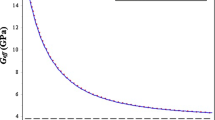Summary
The shear strength of trabecular bone from the femur has been studied. In general, the strongest trabecular bone is found close to the cortico-cancellous junction, though its shear strength depends also on the relationship of the trabeculae to the plane of shear. Some factors affecting the shear strength of the cement-bone interface have been investigated. In vitro, maximal cement-bone interface shear strength is obtained by exposing and thoroughly cleaning strong trabecular bone, and then forcing onto it under pressure low viscosity cement.
Zusammenfassung
Die Scherkräfte der Knochentrabekel des Femur wurden untersucht. Im allgemeinen wird der stärkste travikuläre Knochen nahe des corticospongiösen Überganges gefunden, wobei jedoch die Scherkraft zusätzlich von dem Verhältnis der Knochentrabekel zur Ebene, in der die Scherkräfte wirken, abhängt. Einige Faktoren, die die Scherkraft an der Zementknochengrenze beeinflussen, wurden untersucht. In vitro wird die größte Scherkraft an der Zementknochengrenze erreicht durch Freilegen und gründliches Säubern des starken travikulären Knochens und anschließend durch Einpressen von Zement mit niedriger Viskosität.
Similar content being viewed by others
References
Behrens, J. C., Walker, P. S., Shoji, H.: Variations in strength and structure of cancellous bone at the knee. J. Biomechanics 7, 201 (1974)
Charnley, J.: The reaction of bone to self curing acrylic cement. J. Bone Jt. Surg. 52 B, 340 (1970)
Corkhill, J. A., Croute, D. G., James, M. L., Ling, R. S. M.: Methylmethacrylate metabolism in man. The hydrolysis of methylmethacrylate to methacrylic acid during total hip replacement. (in press, 1978)
Ducheyne, P., Heymans, L., Martens, M., Aernoudt, E., de Meester, P., Mulier, J. C.: The mechanical behaviour of intra-condylar cancellous bone of the femur at different loading rates. J. Biomechanics 10, 747 (1977)
Fitzgerald, E. R.: Dynamic mechanical measurements during the life to death transition in animal tissues. Biorheology 12, 397–408 (1975)
Fitzgerald, E. R.: Postmortem transition in the dynamic mechanical properties of the bone. Med. Physics 4, 49–53 (1977)
Freeman, M. A. R.: The pathogenesis of primary osteoarthritis. In: Modern Trends in Orthopaedics, Vol. 6, A. G. Apley, ed. London: Butterworth's 1972
Galante, J., Rostoker, W., Ray, R. D.: The physical properties of trabecular bone. Calc. Tissue Res. 5, 236 (1970)
Greenwald, A. S., Wilde, A. H.: Some observations on the interface strength of bone cement. Biomechanics Laboratory Research Report, 002-74, The Cleveland Clinic Foundation 1974
Guy, J. G., Jamieson-Evans, D. C., Park, W. M., Rannie, I., Charnley, J.: A long-term micro-focal, radiological and histological study of the reaction of bone to acrylic cement. J. Bone Jt. Surg. 57 B, 113 (1975)
Homsy, C. A.: Prosthesis seating compounds of rapid cure acrylic polymer. Paper read at the National Academy of Science and American Academy of Orthopaedic Surgeons Joint Workshop On Total Hip Replacement and Skeletal Attachment 1969
Homsy, C. A., Tullos, H. S., Anderson, M. S., Differante, N. M., King, J. W.: Some physiological aspects of prosthesis stabilisation with acrylic polymer. Clin. Orthop. 83, 317 (1972)
Jefferiss, C. D., Lee, A. J. C., Ling, R. S. M.: Thermal aspects of self-curing polymethylmethacrylate. J. Bone Jt. Surg. 57B, 511 (1975)
Kolbel, R., Bergmann, G., Rohlmann, A.: Dynamic properties of the bone-cement bond. Paper read at 3rd Annual Meeting of the Society for Biomaterials. New Orleans 1977
Lee, A. J. C., Ling, R. S. M.: A device to improve the extrusion of bone cement into the bone of the acetabulum in the replacement of the hip joint. Biomed. Engineering 9, 1 (1974)
Linder, L.: Reaction of bone to the acute chemical trauma of bone cement. J. Bone Jt. Surg. 59 A, 82 (1977)
Markolf, K. C., Amstutz, H. C.: Penetration and flow of acrylic bone cement. Clin. Orthop. 121, 99 (1976)
Miller, J., Burke, D. L., Stachiewicz, J., Ahmed, A., Kelebay, L.: Loosening of arthroplastic components as a result of blood clot interposed between P.M.M.A. and bone at the time of surgery. Paper read at the 23rd Annual Meeting of The Orthopaedic Research Society, Las Vegas 1977
Miller, J., Tremblay, G. R., Burke, D. L., Ahmed, A., Kelebay, L. C.: The injection of acrylic cement into cancellous bone as a method for the prevention of loosening of arthroplasty components. Paper read at the 24th Annual Meeting of the Orthopaedic Research Society, Dallas 1978
Modig, J.: Studies of the Aetiology and Nature of the Pulmonary and Circulatory Reactions during Total Hip Replacement. Doctoral Thesis at Uppsala University 1975
Pugh, J. W., Rose, R. M., Rodin, E. L.: Elastic and Viscoelastic properties of trabecular bone; dependance on structure. J. Biomechanics 6, 475 (1973)
Singh, M., Riggs, B. L., Beabout, J. W., Jowsey, J.: Femoral Trabecular pattern index for Evaluation of Spinal Osteoporosis. Mayo Clinic Proceedings 48, 184 (1973)
Swanson, S. A. V., Freeman, M. A. R.: Is bone hydraulically strengthened? Med. Biol. Enging. 4, 433 (1966)
Vernon-Roberts, B., Freeman, M. A. R.: Morphological and Analytical Studies of the Tissues adjacent to joint prosthesis: Investigations into the causes of loosening of prosthesis. In: Advances in Artificial Hip and Knee Joint Technology, M. Schaldach, D. Hohmann, eds. Berlin-Heidelberg-New York: Springer 1976
Walker, P. S., Bienenstock, M.: Fixation Properties of acrylic cement. Rev. Hosp. Spec. Surg. 1, 27 (1970)
Walker, T. W., Graham, J. D., Mills, R. H.: Changes in the Mechanical Behaviour of the Human Femoral Head Associated with Arthritic Pathology. J. Biomech. 9, 615 (1976)
Willert, J.-G., Ludwig, J., Semlisch, M.: Reaction of Bone to methacrylate after hip arthroplasty. J. Bone Jt. Surg. 56 A, 1368 (1974)
Author information
Authors and Affiliations
Additional information
This investigation was supported by Howmedica International Ltd., North Hill Plastics Division, 622 Western Avenue, Park Royal, London, W3 OTF, and by The Northcott Devon Medical Foundation Exeter
Rights and permissions
About this article
Cite this article
Halawa, M., Lee, A.J.C., Ling, R.S.M. et al. The shear strength of trabecular bone from the femur, and some factors affecting the shear strength of the cement-bone interface. Arch. Orth. Traum. Surg. 92, 19–30 (1978). https://doi.org/10.1007/BF00381636
Received:
Issue Date:
DOI: https://doi.org/10.1007/BF00381636




